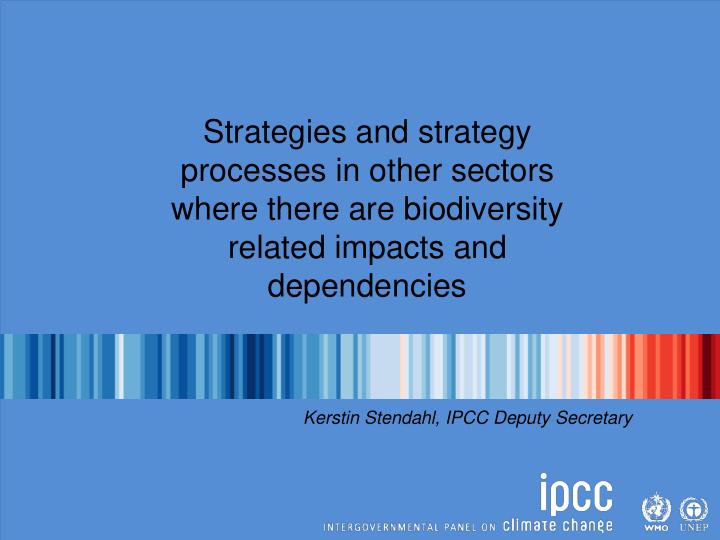



Strategies and strategy processes in other sectors where there are biodiversity related impacts and dependencies Kerstin Stendahl, IPCC Deputy Secretary
May 2019 Emission inventories October 2021 April 2022 October 2018 April 2021 September 2019 Climate Change The Synthesis Global Oceans The Physical Impacts, Report warming of and cryosphere Science Basis Adaptation and o C 1.5 Vulnerability Mitigation Land Global of Talanoa stocktake Climate Change dialogue 2023 UNFCCC August 2019 July 2021 UNFCCC * Dates are subject to change
The Global Stocktake under the Paris Agreement Article 14 of the Paris Agreement • provides for a periodic global stocktake "of the implementation of this Agreement to assess the collective progress towards achieving the purpose of this Agreement and its long-term goals." • The stocktake should be done in a "comprehensive and facilitative manner, considering mitigation, adaptation and the means of implementation and support, and in the light of equity and the best available science”. • The CMA will undertake the first global stocktake in 2023 and every five years thereafter, unless otherwise decided by the CMA.
IPCC Task Group on the organisation of future work of the IPCC in light of the Global Stocktake • identify issues and options for consideration by the Panel on the organization, including timing, of the future work of the IPCC, including with particular regard to the seventh assessment cycle, taking into account the scientific information needs of the global stocktake and of the UNFCCC more generally, as well as audiences and purposes served by IPCC assessments • pros and cons of different options, including quality of reports and implications for operations, resourcing, budget and contributions of the research community. • options will preserve the scientific integrity and the independence of the IPCC, and robustness, scope and depth of its products
5 SAICM is a policy framework, established in 2006, promoting chemical safety around the world • Multi-sectoral and multi-stakeholder • Coordinates, convenes & catalyzes action • Voluntary, complements existing efforts • Builds capacity at country and regional level • Addresses emerging issues • Governed by the International Conference on Chemicals Management • Germany to host and preside over the fifth session of the Conference in October 2020 in Bonn. Overall Objective of SAICM : Achieve the sound management of chemicals throughout their lifecycle by 2020
6 Possible decision points for beyond 2020 1. How to support an ambitious overarching approach on chemicals and waste: • Strong and visible leadership by UNEP, including in the High Ambition Alliance, led by Sweden & Uruguay 2. How to enhance industry engagement from the chemicals and waste cluster: • UNEP to promote and lead on new ideas to support coordination and delivery on innovation, circular economy, textiles and plastics agenda 3. How to use strategic science messaging from relevant assessments: • Pollution as one of the main drivers of biodiversity loss • Promote stronger science for policy making on chemicals and waste
The BRS Conventions on chemicals and hazardous wastes Basel Convention on the Control of Transboundary Movements of Hazardous Wastes and their Disposal , 1989, 187 Parties Rotterdam Convention on the Prior Informed Consent Procedure for Certain Hazardous Chemicals and Pesticides in International Trade, 1998, 161 Parties Stockholm Convention on Persistent Organic Pollutants, 2001, 182 Parties Joint conferences of the Parties (TRIPLECOPs) every two years – 2019, • 2021, 2023
The synergies process: milestones 2017 2010 2006 3 rd Omnibus 2013 Tripl Establish decisions 1 st Triple e ment of at Ex- COP AHJWG COPs COPs s 2011 2019 2015 2008-2009 4 th Identical 2 nd Synergies Triple synergies Tripl decisions COPs decisions e adopted adopted COP by each s COP www.brsmeas.org @brsmeas
Basel Convention - designed to reduce the movements of hazardous wastes between nations, and specifically to prevent transfer of hazardous waste from developed to less developed countries - intended to minimize the amount and toxicity of wastes generated, to ensure their environmentally sound management as closely as possible to the source of generation, and to assist LDCs in environmentally sound management of the hazardous and other wastes they generate. - Basel Convention Plastic Waste amendment adopted at BC COP-14 in May 2019, impacts of plastic use (using petrochemical as raw materials) and ESM of plastic waste (energy recovery vs. temperature increase) – link to biodiversity, impacts of plastic litter in the environment (entanglement, ingestion, microplastics, chemical additives etc.)
Rotterdam Convention The chemicals listed in Annex III include pesticides and industrial chemicals that have been banned or severely restricted for health or environmental reasons by two or more Parties and which the Conference of the Parties has decided to subject to the PIC procedure. There are a total of 50 chemicals listed in Annex III, 34 pesticides (including 3 severely hazardous pesticide formulations), 15 industrial chemicals, and 1 chemical in both the pesticide and the industrial chemical categories. - Chemicals Review Committee (CRC)
Stockholm Convention In response to this global problem, the Stockholm Convention, which was adopted in 2001 and entered into force in 2004, requires its parties to take measures to eliminate or reduce the release of POPs into the environment. Annex A, elimination, 24 POPS of which 15 pesticides Annex B Restriction, 2 chemicals Annex 7, unintentional production, 7 POPS http://www.pops-gmp.org/ (Global monitoring plan on persistent organic pollutants) - Persistent Organic Pollutants Review Committee
Recommend
More recommend